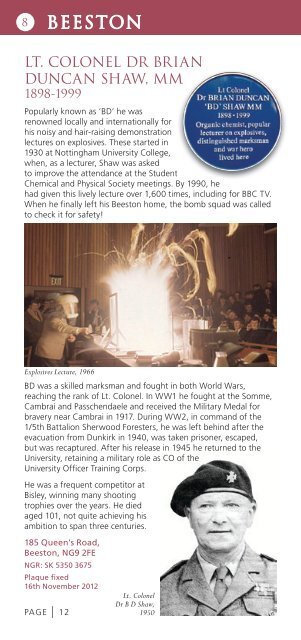GUIDE TO THE BLUE PLAQUES
BP%20final%20proof.2016.05.03
BP%20final%20proof.2016.05.03
You also want an ePaper? Increase the reach of your titles
YUMPU automatically turns print PDFs into web optimized ePapers that Google loves.
BEES<strong>TO</strong>N<br />
BEES<strong>TO</strong>N<br />
8 9<br />
LT. COLONEL DR BRIAN<br />
DUNCAN SHAW, MM<br />
1898-1999<br />
Popularly known as ‘BD’ he was<br />
renowned locally and internationally for<br />
his noisy and hair-raising demonstration<br />
lectures on explosives. These started in<br />
1930 at Nottingham University College,<br />
when, as a lecturer, Shaw was asked<br />
to improve the attendance at the Student<br />
Chemical and Physical Society meetings. By 1990, he<br />
had given this lively lecture over 1,600 times, including for BBC TV.<br />
When he finally left his Beeston home, the bomb squad was called<br />
to check it for safety!<br />
BEES<strong>TO</strong>N STATION<br />
Opened 1839<br />
Beeston is the only station on the<br />
Nottingham to Derby line to have<br />
remained continuously on the same site<br />
since being opened to the public by the<br />
Midland Counties Railway on 4th June<br />
1839. The company’s other route, from<br />
Trent Junction to Leicester and Rugby,<br />
opened in 1840.<br />
The surveyor of the line was Charles B Vignoles, an eminent railway<br />
engineer who had developed the use of the flat-bottom rail. The<br />
Midland Counties forbade him to employ it on their lines, but it is<br />
now used, very successfully, worldwide.<br />
In 1844, the Midland Counties Railway, the Birmingham and Derby<br />
Junction Railway and the North Midland Railway, amalgamated to<br />
form the Midland Railway. In 1847 this company replaced Beeston’s<br />
original small station building with the one still in use today.<br />
Explosives Lecture, 1966<br />
BD was a skilled marksman and fought in both World Wars,<br />
reaching the rank of Lt. Colonel. In WW1 he fought at the Somme,<br />
Cambrai and Passchendaele and received the Military Medal for<br />
bravery near Cambrai in 1917. During WW2, in command of the<br />
1/5th Battalion Sherwood Foresters, he was left behind after the<br />
evacuation from Dunkirk in 1940, was taken prisoner, escaped,<br />
but was recaptured. After his release in 1945 he returned to the<br />
University, retaining a military role as CO of the<br />
University Officer Training Corps.<br />
He was a frequent competitor at<br />
Bisley, winning many shooting<br />
trophies over the years. He died<br />
aged 101, not quite achieving his<br />
ambition to span three centuries.<br />
185 Queen’s Road,<br />
Beeston, NG9 2FE<br />
NGR: SK 5350 3675<br />
Plaque fixed<br />
16th November 2012<br />
PAGE | 12<br />
Lt. Colonel<br />
Dr B D Shaw,<br />
1950<br />
Beeston Station, c.1904, courtesy of Mr W Spencer and www.picturethepast.org.uk<br />
With the 1923 grouping of Britain’s railways, the Midland Railway<br />
became a part of the London, Midland and Scottish<br />
Railway, until nationalisation<br />
in 1948. Beeston Station<br />
achieved Grade II listing<br />
in 1987. In 1988, having<br />
fallen into a very poor<br />
state of repair, British<br />
Rail sympathetically<br />
restored the building to<br />
its Victorian splendour.<br />
Station Road,<br />
Beeston, NG9 1JU<br />
NGR: SK 5338 3623<br />
Plaque unveiled<br />
8th October 2014<br />
Beeston Station, 1839<br />
R.Allen’s Nottingham and Derby Railway Companion<br />
PAGE | 13


